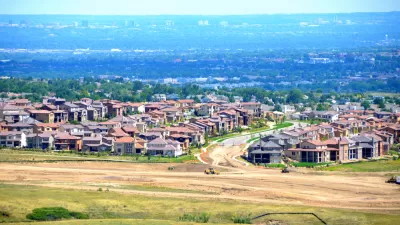The pandemic has resulted in an an increasing preference for sprawl among Americans, according to the findings of a recent Pew Research Center "American Trends Panel."

Vianney Gomez shares the findings of an "American Trends Panel" survey conducted this summer by the Pew Research Center.
"Americans today are more likely than they were in the fall of 2019 to express a preference for living in a community where 'houses are larger and farther apart, but schools, stores and restaurants are several miles away,'" writes Gomez to summarize those findings.
"There has been a corresponding drop in the share saying they would prefer to live somewhere with smaller houses that are 'closer to each other, but schools, stores and restaurants are within walking distance,'" according to Gomez.
The article provides additional insight into the demographic breakdown of the trend in U.S. housing preference. Previous trends in political preference only increased, according to the survey, but with both Republicans and Democrats increasing their preference for large homes and dispersed development:
As in the past, Republicans and Republican-leaning independents are more likely than Democrats and Democratic leaners to say they want to live in a community with larger houses even if there are greater distances to schools, shops and restaurants. Today, 73% of Republicans say this, up from 65% in September 2019. About half of Democrats (49%) now say they would prefer to live in a more widely spaced community, up from 42%.
Additional breakdowns for race, where respondents currently live, and by age are also included in the article.
The news about American housing preferences seems to be working at odds with the changes that will be necessary to prevent the worst outcomes of climate change, according to the Sixth Assessment Report published this summer by the International Panel on Climate Change. A 2019 IPCC report explicitly named U.S. land use and driving habits as a significant contributor to climate change.
The survey findings also seem counterintuitive in context of the obvious demand for city living in the United States, as evidenced by housing prices in cities and a housing affordability crisis that has only picked up pace since the pandemic began.
FULL STORY: More Americans now say they prefer a community with big houses, even if local amenities are farther away

Alabama: Trump Terminates Settlements for Black Communities Harmed By Raw Sewage
Trump deemed the landmark civil rights agreement “illegal DEI and environmental justice policy.”

Study: Maui’s Plan to Convert Vacation Rentals to Long-Term Housing Could Cause Nearly $1 Billion Economic Loss
The plan would reduce visitor accommodation by 25% resulting in 1,900 jobs lost.

Why Should We Subsidize Public Transportation?
Many public transit agencies face financial stress due to rising costs, declining fare revenue, and declining subsidies. Transit advocates must provide a strong business case for increasing public transit funding.

Paris Bike Boom Leads to Steep Drop in Air Pollution
The French city’s air quality has improved dramatically in the past 20 years, coinciding with a growth in cycling.

Why Housing Costs More to Build in California Than in Texas
Hard costs like labor and materials combined with ‘soft’ costs such as permitting make building in the San Francisco Bay Area almost three times as costly as in Texas cities.

San Diego County Sees a Rise in Urban Coyotes
San Diego County experiences a rise in urban coyotes, as sightings become prevalent throughout its urban neighbourhoods and surrounding areas.
Urban Design for Planners 1: Software Tools
This six-course series explores essential urban design concepts using open source software and equips planners with the tools they need to participate fully in the urban design process.
Planning for Universal Design
Learn the tools for implementing Universal Design in planning regulations.
Smith Gee Studio
Alamo Area Metropolitan Planning Organization
City of Santa Clarita
Institute for Housing and Urban Development Studies (IHS)
City of Grandview
Harvard GSD Executive Education
Toledo-Lucas County Plan Commissions
Salt Lake City
NYU Wagner Graduate School of Public Service





























